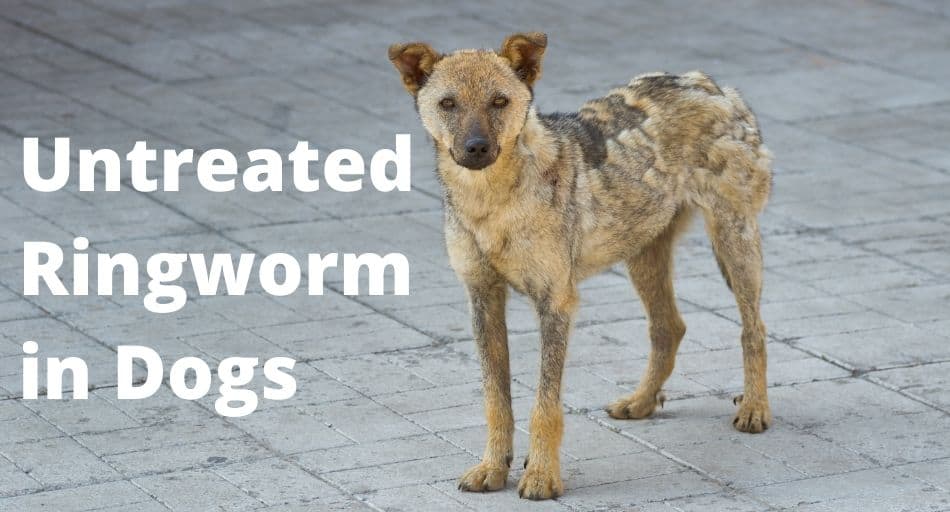As an affiliate, we earn from qualifying purchases on Amazon. We get commissions for purchases made through links in this post.
If you’re worried that your dog has come into contact with ringworms, you might be wondering how dangerous that could be. Can ringworm kill a dog?
We’ll be looking at some of the risk factors that ringworms pose to our canine companions. Ways to treat them and prevent any future reoccurrence.
Ringworm, unlike many parasites your dog might pick up, is not actually a worm at all; it’s a fungus. The fungus grows in the outer layer of skin and the hair follicles, and is usually quite localized, only affecting small areas of the body.
Vulnerable dogs such as puppies or elderly canines may suffer from worse infections.
But can they kill your dog if left untreated?
Let’s find out.
Can Ringworm Kill A Dog?
Ringworm is not usually very dangerous to our four-legged friend, although it is highly contagious and may need veterinary treatment. Young puppies and elderly dogs should not be at much risk of ringworm, but it is quite uncomfortable to them and needs addressing promptly. They, however, won’t kill your dog.
It is also easy for your dog to pass it on to other dogs and it can also be transferred to humans, especially children, so it’s important to treat it quickly and effectively.
To better treat ringworms in dogs, you need to first get an understanding of some of the key symptoms you should be on the lookout for.
These symptoms will include:
- Circular patches of hair loss
- Rough claws or brittle claws
- Inflamed, irritated skin
- A brittle coat
It’s important to note that many of these symptoms can also indicate other conditions, such as an existing skin problem. It’s, therefore, recommended to seek your vet’s opinion on this to ensure the right ringworm diagnosis is provided and also for them to prescribe the appropriate treatments.
Take your dog to the vet if he is showing signs of ringworm or other skin problems, and make sure that you and your children wash your hands whenever you touch him. Avoid sharing bedding or furniture in the interim.
How Did my Dog Get Ringworm?
Ringworms in dogs spread through contact with the fungus. This will happen when your dog gets into contact with an infected animal or person. It can also spread through touching contaminated objects and areas such as their bedding, feeding bowl, or through your couch. Anywhere contaminated by the ringworm fungus.
The fungal spores can last up to 18 months in an infected area. They spread the most during their shedding season or breaking of the infected hairs. This could be the case if your canine friend lives with other pets that could have been infected by ringworm.
When treating your dog, you should consider treating all the other pets that you have in your homestead as well as keep him away from your neighbor’s pet until they treat theirs as well.
Can I Touch my Dog if he has Ringworm?
Ringworms are highly contagious. With that said, it’s not recommended to touch your dog once they have been diagnosed with ringworm. The ringworm could be transmitted to you and your family members.
You should keep your kids far away from an infected dog until it’s treated.
When treating ringworm make sure to wear protective gear to prevent yourself from getting infected. This includes a glove and an apron.
How to Get Rid of Ringworm on a Dog?
Your vet will give you something to treat ringworm once they have diagnosed your dog. This might be tablets that you have to give them or a topical medicine that you can apply to the affected areas of skin. Occasionally, you may need both. Follow the instructions carefully to ensure the medicine works.
Your vet may also recommend clipping long hairs to speed up the treatment and control the situation. This could also mean just clipping the affected areas most of the time.
You will then need to spend time disinfecting and cleaning your environment. Because it is a fungus, ringworm spreads via spores, so you won’t see any signs of it – but it will be there. You should disinfect hard surfaces that your dog is near, and clean all your dog’s toys with a pet-safe disinfectant.
Soft toys and things like blankets need to be washed on a very hot wash, and you should steam clean furniture like sofas or carpets. Do this repeatedly, as it can take time to get rid of issues with ringworm. Several treatments are likely to be necessary. Twice weekly should be sufficient.
Try to think about everything that your pet has come into contact with, including things like curtains, hard floors, food bowls, children’s soft toys, etc. You need to be very thorough or the infection may recur. Anything that cannot be cleaned needs to be disposed of.
How Can I Treat my Dog’s Ringworm Without Going to the Vet?
Are there any home remedies for treating ringworms? Let’s find out.
There are three most common natural remedies for treating ringworms in dogs, these natural remedies don’t necessarily require any preparation other than the vet’s diagnosis of ringworm presence on your dog.
The 3 common home (natural) remedies to treat ringworms are:
- Anti-Fungal Pet Shampoo: Using an anti-fungal pet shampoo helps with fighting and eliminating ringworms. Wash your dog with the anti-fungal pet each and every day until the infection is completely gone.
- Apple Cider Vinegar: This will help with relieving the itchiness and sores that are caused by ringworms in the affected areas. To use this, make a 50 / 50 solution of the apple cider vinegar and water; using a spray bottle, spray the infected areas 3 times a day until the infection is completely gone.
- Tea Tree Oil: Tea tree oil is known to have curative properties when applies to the affected areas. They also aid with any discomfort that could be a result of ringworms. To use this method, dilute tea tree oil with water (aiming for a percentage of 1%) then gently apply to the infected area twice a day for one week.
These natural remedies have proved to be very successful especially the anti-fungal pet shampoo as it’s used to wash the dog’s entire body.
If the condition worsens you should seek advice from your local vet on the best prescription meds that would work for your four-legged friend.
Untreated Ringworm in Dogs
If left untreated, ringworms in dogs can become quite a nuisance not only to your dog but also to other members of your household. It can be quite unsightly on your dog and can easily spread to other parts of your dog’s body. It will spread to other parts of your dog’s body leading to other issues such as skin, hair, and nails problems. This can also lead to skin cracks and blisters that can easily be infected with bacteria.

Untreated ringworms in dogs are not life-threatening, but this doesn’t mean you shouldn’t take good care of your four-legged friend. Treatment may help speed up recovery and leave you with a happy and healthy doggo.
Ringworms will eventually go away on its own, but as it heals, there are high chances that it may spread to a wider area of your dog’s body as well as possible to be passed to other pets as well as other people within the household.
Conclusion
If you’ve ever wondered if ringworms can kill your dog now you know. Ringworm is not likely to kill your dogs. It is not dangerous, but can be uncomfortable for the dog, and can easily spread to other pets, or to you and your family members.
Treat ringworm promptly, and disinfect the environment to stop it from coming back.
You should avoid touching your dog with your bare hands until the ringworm situation is controlled. This will help prevent the infection from being transmitted to you and your family members.


1 thought on “Can Ringworm Kill A Dog? (How to Treat Them)”
Comments are closed.